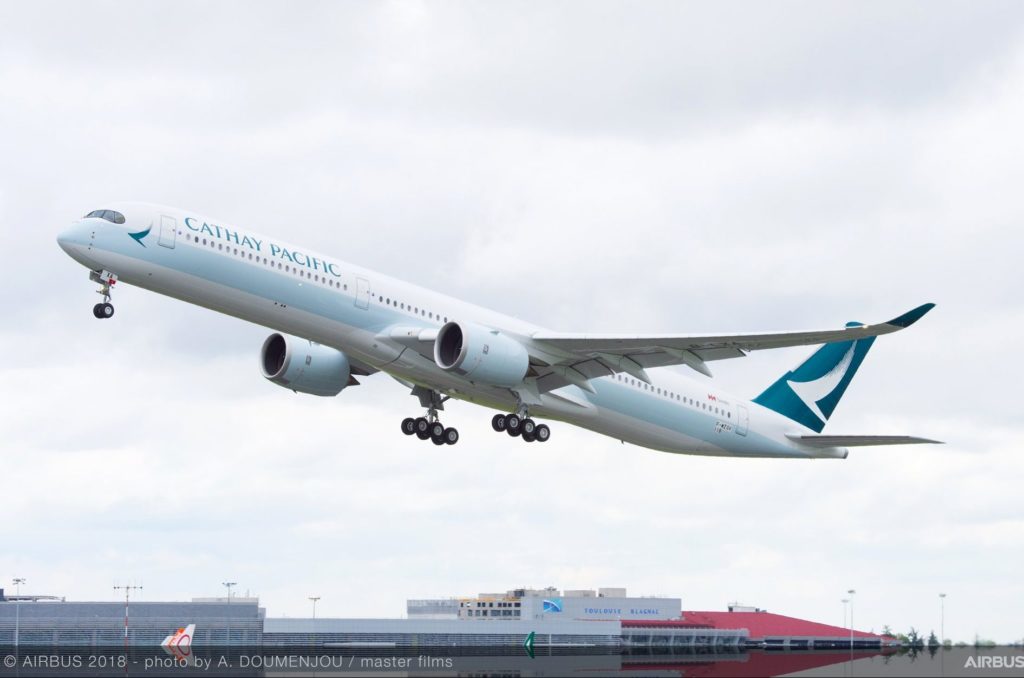New Cathay Seats Face Delays as Aircraft Deliveries Are Re-Negotiated
Share

In light of COVID-19, Cathay Pacific is following the well-established aviation downturn playbook by preserving cash. Initial steep capacity cuts and asking staff to voluntarily take unpaid leave are now being followed by capital expenditure adjustments. Looking forward, the airline still plans to take delivery of 70 new aircraft – mostly widebodies – by 2024, but is re-negotiating the timing with Airbus, Boeing and leasing companies.
During Cathay Pacific’s 2019 annual results press conference today in Hong Kong, the carrier confirmed it is negotiating with Airbus and Boeing to defer deliveries of new aircraft, some of which were set to mark the introduction of new seating products to its fleet.
Cathay was due to take delivery of its first Airbus A321neo and additional A350s this year, followed by its first Boeing 777-9 in 2021. “We’re in discussions about deferring delivery of aircraft for this year. I think that’s prudent,” explained COO Greg Hughes, adding that the new delivery dates still need to be finalized.
Hughes did not say which models or how many could be delayed. Cathay has no Boeing aircraft due for delivery this year, so negotiations with the US airframer could indicate changes to the payment structure for next year’s 777s, or outright delays for next year’s deliveries, too. However, the airline still intends to take its full orderbook, which will see 70 new aircraft deliveries by 2024.
“We’re in discussions about deferring delivery of aircraft for this year. I think that’s prudent.” – Greg Hughes, Cathay Pacific
The talks come as Cathay responds to the coronavirus downturn by cutting 65% of its available seat miles and 75% of flights next month. The first half of the year will see the airline post a “substantial loss,” but management is apparently planning for a rebound during the second part of 2020.
The first A321neo, which will be used by Cathay’s regional arm, Cathay Dragon, has been spotted partially painted at Airbus’ Hamburg assembly plant. The aircraft, which is one of a total order of 16 of the type, is due to introduce a new regional business-class product, but Cathay has yet to divulge specifics. The carrier also flagged a new first-class product for its Boeing 777-9s. Six of the twenty-one 777-9s it has on order are due for delivery in 2021.
“We’re asking all our vendors and business partners for relief in the form of deferrals and discounts to help us preserve cash.” – Patrick Healy, Cathay Pacific
Newly-acquired LCC subsidiary HK Express was also supposed to receive four A320neos this year and one next year, all on operating lease. Hughes said Cathay is in discussions with lessors about delaying the leased aircraft.
While aircraft deliveries comprise most of Cathay’s capital expenditure plan, other companies will be contacted, too. “We’re asking all our vendors and business partners for relief in the form of deferrals and discounts to help us preserve cash,” said chairman Patrick Healy. “Cathay Pacific is a very good customer when times are good but we expect all of our vendors and business partners to come to the table now when we need them to.”
In the downturn during the Global Financial Crisis, Airbus was able to work with airlines and move over 600 aircraft orders between 2009-2011, Bloomberg reported this week. But Airbus and Boeing also need to preserve their own liquidity.
And while most major airlines enter the coronavirus downturn from a position of strength, Cathay had a weak second half of 2019, due to months-long protests in the city. Cathay swung from a $161-million profit in the second half of 2018 to a $56-million loss in second half of 2019, a period that should have seen a higher year-on-year profit as Cathay completed its restructuring. But unlike other airlines, Cathay has major profit earnings from investments in subsidiaries and associates, namely Air China. Those investments more than offset the bulk of the airline’s loss and kept the Cathay group in the black in the second half of the year.


